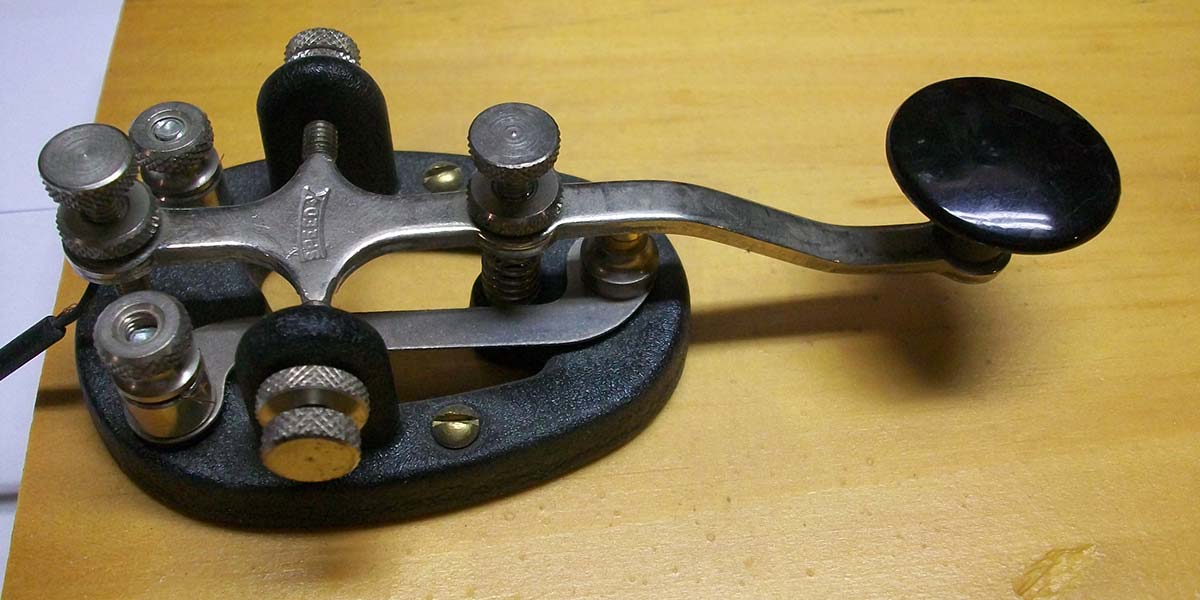Since the inception of ham radio until the early 2000s, the licensing of an individual to become a ham radio operator has required an examination in sending and receiving international Morse code, CW, or “continuous wave” (as opposed to spark transmissions, which were intermittent). The reason for this was that the on/off nature of Morse code was reliable, needing the minimum of technology to implement, and that frequency stability and selectivity of early radios did not facilitate voice transmission and reception. There are many quant videos of military training films for Morse code instruction. To put it simply (which I try to do, sometimes too simply), almost any individual — especially one with musical ability — can learn Morse code in about two weeks to the five words per minute level (WPM), and about six weeks to the 13 WPM level.
There are innumerable methods of learning the code — most of them free, with some available on CDs. The “best” method is to find a buddy to which to send, and have him send to you also, using a straight key and a buzzer. Often in today’s world, a buddy for this is difficult to find unless you want to play a video game or have a flash crowd, so the online methods are often used. Some ham radio clubs have CW courses, and some are conducted on 2M repeaters after the club net. CWops has a CW Academy that’s run on Skype, with demand far exceeding supply, and SKCC has mentors with whom you can make schedules on the air to improve your CW speed.
Morse code has the ability to get through interference caused by other stations, fading, and atmospheric or man-made noise. It is not as good as JT65 or WSJT (invented by Jim K3JT) or PSK31, but in its simplest form it does not require a computer. The most used computer program for CW is FLdigi, but there are many others available. One of the advantages of CW is that it requires a bandwidth of only 200 Hz even at fast speeds (30 WPM), and the receiving station uses a simple audio or IF filter in order to cut down noise and adjacent channel interference. Morse code basically won/lost World War II.
These are among the many reasons that ham radio equipment universally accommodates CW reception and transmission.
For CW reception, the receiver requires a beat frequency oscillator; that is, an oscillator near to the intermediate frequency in a superhet receiver. In the years before 1960, this was done by simple injection using a gimmick capacitor (a few picofarads). After this date, the product detector was invented which really increased the distortion-free capacity of the detector — especially after audio based automatic gain control was invented (this is a standard feature of all modern HF receivers). Refer to Figure 1.
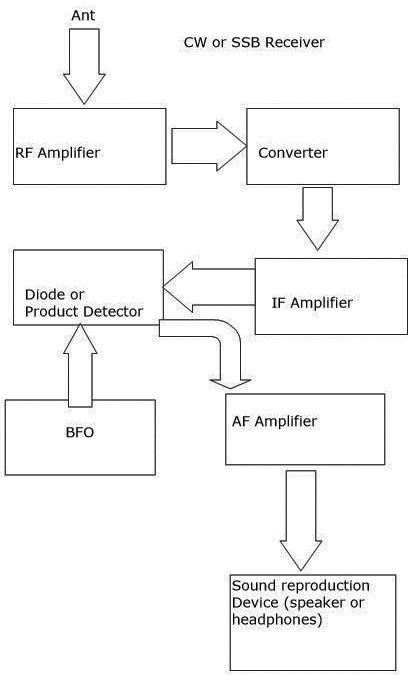
FIGURE 1. Superhet receiver with BFO schematic.
One of the advantages of CW (without going into the math) is that it is inherently 3 dB more interference-penetrating than single sideband. Single sideband is much more efficient than simple amplitude modulation (ancient modulation, as hams call it). In actual practice, with the use of narrow audio or intermediate stage filters, these were universally crystal filters (in the old days), with the crystal filter being at the IF frequency, and cascaded for single sideband in order to get a flat passband over several Kc. This cascaded in modern simple rigs in order to get a narrow CW filter; the actual advantage of CW is at least 10 dB. The ability to use a narrow filter (in practicality, 100 Hz for slow CW) knocks down the adjacent noise greatly. Slowing the speed to 5 or 10 WPM and using multiple repeats gets out extremely well. This was recognized by the military.
In addition, if you were stranded on a desert island with only an AM radio, you could unwind turns from the loop antenna and oscillator coil, make the IF regenerative, and you’d be on the air for an emergency radio (if you could figure out a way to get the RF stage to oscillate on transmit at its base frequency). I realize this is stretching things a bit, but it certainly invokes views of the movie, The Martian.
Initially, CW is sent with the use of a straight key (Figure 2).
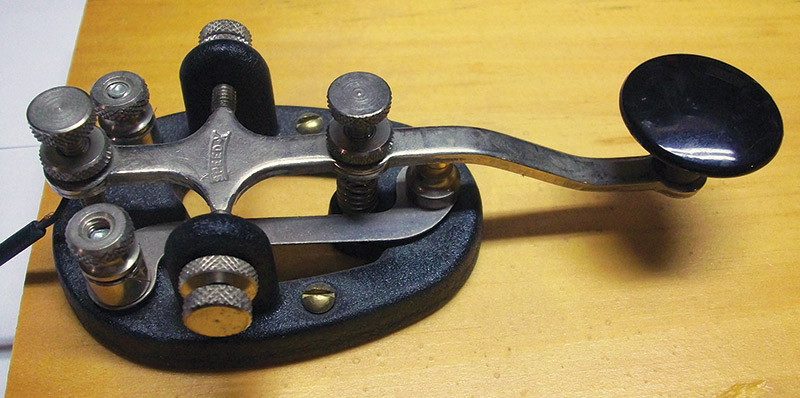
FIGURE 2. Straight key.
When greater speed is needed, a “bug” (semi-automatic key) is used. This has an arm on a tempered steel support that bounces back and forth to make dots. The dashes are made with the round portion of the knob (Figure 3).
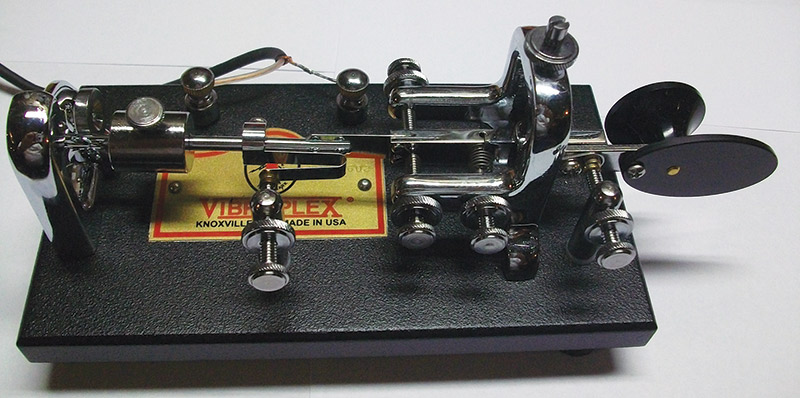
FIGURE 3. Semi-automatic key (bug).
After that, an automatic key is used (Figure 4).
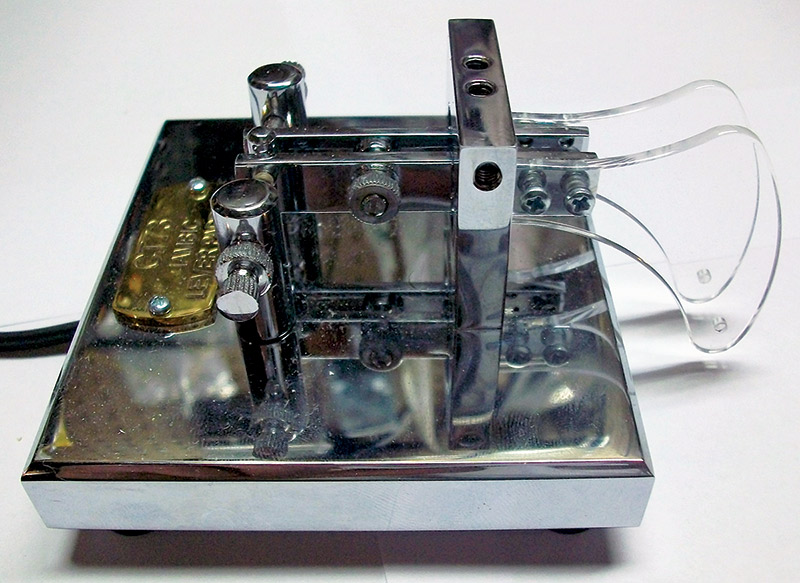
FIGURE 4. Fully automatic keying lever (iambic).
This has self-completing dashes, often automatic letter and word spacing, and the ability to send dah-di-dah-di, etc., when both levers are pressed (Iambic).
There is a difference between iambic A and B, but A works for me. Many hams are going back to the non-iambic single lever type of paddle. Many new hams do not use a key at all; the CW is sent from their computer from the DB-9 port or through a simple USB to DB-9 converter. The modern K1EL system bypasses everything, and uses a nice USB port to send memories out on the air.
Every CW operator has their favorite key/keyer. There is a large variety of keyer and keyer kits available (Figure 5).
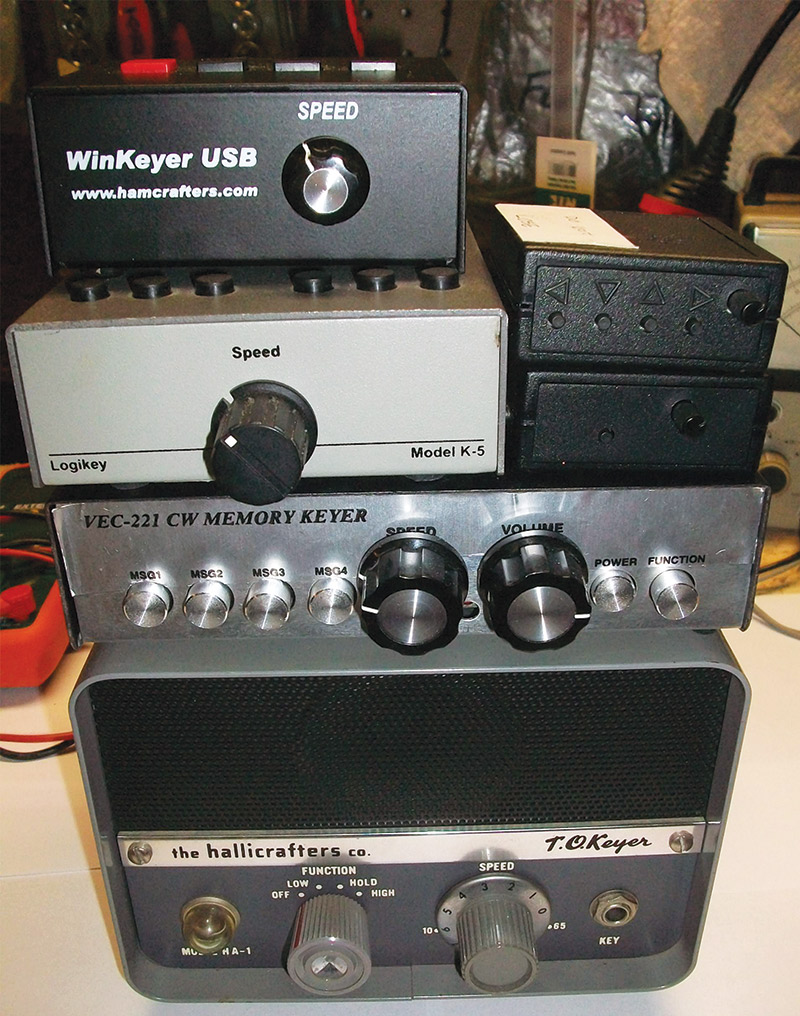
FIGURE 5. Stack of keyers.
The cheapest high performance keyer is the PicoKeyer ultra kit from HamGadgets ($29). The cheapest good dual lever paddle is a used Bencher BY-1 found on eBay.
Additional techniques that allow CW to get through in the face of poor conditions (atmospheric noise, fading, no Internet, no satellite phone, flooding, earthquake, or tsunami disaster) are use of slower speeds and repetition (twice for each word).
There is a special time-saving language for CW which predates texting abbreviations by about 90 years, and actually many texting abbreviations have been derived from this list. The abbreviations in the sidebar are just some examples.
CW ABBREVIATIONS
A: 1
B: Be
ABT: About
AGN, ?: Repeat
ANT: Antenna
B4: Before
BCNU: Be seeing you
C: Yes
CFM, QSL: I acknowledge accurate receipt
CUL: See you later
DE: From (from the French)
FB: Fine business (good)
FER: For (e is shorter on CW than o)
GNG: Going
HI HI: Laughter (sounds like laughter)
HR: Here
HV: Have
K: Go ahead
KN: (run together) Go ahead the station specified only
GL: Good luck
GNG: Going
GUD: Good
MNI: Many
N: No or 9 (as in 5NN, short for 599)
ND: Nothing doing
NR: Number
OM, OC, OD, OT: Old man, old chap, old dog, old timer ... any male human over the age of four. Old timer is always a compliment.
QRP: Low power, output 5W or less
QRS: Slow down
QRT: I am going off the air
QRQ: Send faster
QRU: I have nothing for you, please go away. Often said if the other ham is from another faction of ham radio.
QRZ?: Who is calling me?
QSO: Contact
QSY: Change frequency
QTH: My location is
RIG: Setup
RST: Readability, strength, tone (1-5, 1-9, 1-9)
RX: Receiver
T or O: Zero
TNX: Thanks
TT: That
TU: Thank you
TX: Transmitter
U: You
WX: Weather
XMIT: Transmit
XYL: A married female
YL: Young lady ... a female human
WRK: Work (i.e., contact or converse with)
2: To
73: Best regards
88: Love and kisses
Use of these abbreviations makes CW very enjoyable, and at 20 to 25 words per minute, a conversation almost as fast as human speech can be made (speech is typically 100 to 220 WPM, and more like 180 WPM for the younger generation, who don’t enunciate their words). Most hams copy by ear, and the younger generation copies with FLdigi or Skimmer.
It is traditional to make notes of what is said by the other station. Many hams repeat what has been said to them back to the initial station (why I have no idea). Also, with electronic logging, you can make notes of what was said during the last conversation (QSO) and ask the ham if he still has the same rig, antenna, dog, wife, country estate, condo, balcony antenna, invisible antenna, how many years they have been a ham, the number of countries worked, vertical, any kits just built, money saved on a new radio, the local ham craze, the rudeness of other hams, how to keep XYL happy, professional success, etc. These are all of great interest to amateurs.
There are many CW organizations. These include the FISTS (primarily for slow speed operators); SKCC (for those that use mechanical keys and also for those who use low power); CWops, for those deemed to have a good “fist” (sending ability and accuracy with proper spacing) at 28 WPM; a spinoff of the Chicken Fat Operators high speed club, founded by W9TO (inventor of the electronic key); and the FOC (Fine Operator’s Club, a more exclusive version of the CWops, run by the British).
The fellowship factor in CW communication is very great — much greater than with other organizations. I’m not exactly sure the reason for this. Many of the CW operators speak of getting their CW “fix” for the day.
For me, the CW fix is around one to two hours each day. It has often been said that in order to enjoy CW, you must copy by ear (this takes about two months, but some can never accomplish it). Of course, Morse code must be used often — as any language — in order to maintain proficiency.
The popularity of CW and radio teletype (RTTY) “contesting” (making as many contacts as possible in a prescribed amount of time) has skyrocketed. This is most likely due to the availability of automatic test detection and sending, extremely accurate frequency readout and stability of modern rigs, and the reverse beacon network with the use of “telnet” nodes (Internet connected site which tells you where to tune for a station; with modern computer-connected transceivers; this only requires one click). RBN (Reverse Beacon Network) has computer-detected callsigns on CW and RTTY. RTTY contesting is growing around 10% a year.
The death of CW has been predicted for at least 30 years, but it seems as though Morse code is similar to a pesky fly. You chase it off and it is then seen 20 minutes later crawling up the desk again. It is very difficult to eradicate. NV
CW Resources
www.arrl.org/learning-morse-code
www.cwops.org
www.dxzone.com/catalog/Software/Morse_Code_Training
www.fistsna.org
www.g4fon.net/CW%20Trainer.htm
www.hamgadgets.com
k1el.tripod.com
www.mfjenterprises.com
(search for keyer)
www.morsex.com/idiom
www.ng3k.com/Misc/cluster.html
www.reversebeacon.net
www.skccgroup.com
www.vibroplex.com/contents/en-us/d62.html
www.w1hkj.com
Corrections
In the March 2017 "Print" edition, Figure 3 should be Figure 4 and vice versa. They appear correctly here.

